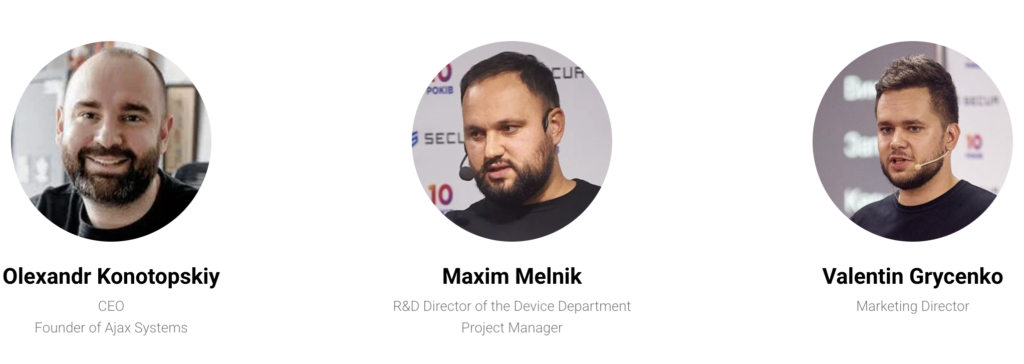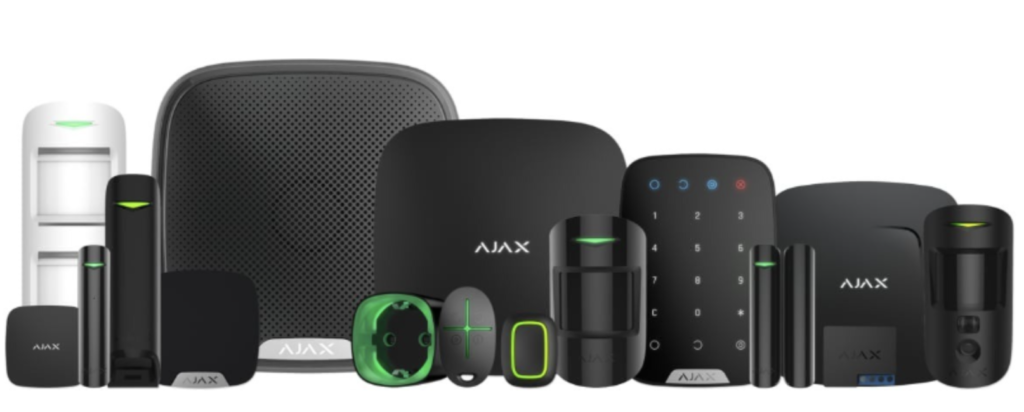What is Ajax Systems?
Ajax Systems produces wireless security systems and does a good job of it – the company has 900,000 customers from more than 120 countries. The R&D department of four departments in Kyiv is responsible for the development of devices: software and device development, automation and testing. The total staff is about 350 specialists. The team studies what characteristics the device should have, makes a prototype, tests, refines it and certifies it. The result is a lineup of 36 devices and mobile app updates.
“One of the tasks is to constantly monitor the challenges of the market and respond to them with new engineering solutions,” says Maxim Melnik, R&D Director of the Device Department.
Ajax devices run on OS Malevich, and all data is stored in the Ajax Cloud. The Ajax sensor system has also learned to detect movements not only in the house, but also outside it, so it can notify in advance of a suspected theft. For reliable data transmission over a distance of up to 2 km, a proprietary Jeweler protocol was developed.
Leaders of Ajax Systems

In 2008, Olexandr’s school friend Yevhen Humenyuk asked for advice on choosing a security system for the house. They did not find a suitable one in Ukraine, so they ordered it from Russia. It turned out to be cheaper there. Friends came up with the idea to make a business out of it.
Initially, security systems were brought in small batches by passenger trains from Russia. Then they switched to direct purchases from China. This happened when the entrepreneurs discovered that the instructions for the security system were translated to Russian from Chinese. The success of the business idea exceeded expectations – sales grew. In Ukraine, such systems cost $600-700, and Konotopskyi and his partner set a price of $320. At the same time, all sales went through the online store created “on the knee”.
However, the capabilities of Chinese sensors were not suitable for the professional market. The sensors did not report a low charge level, they had a small range, and had a lot of other disadvantages. If the sensor was breaking, the security company could not find out about it. Chinese manufacturers could not improve quality, and it was expensive in Taiwan and Europe.
This is how the company Secur appeared. Two founders invested $5,000 each in fixed assets and working capital. The devices sold well among end users, but entrepreneurs wanted to reach out to integrators and security companies. They promised growth in turnover and a stable sales market.
The company Secur, which specialized in the resale of Chinese alarm systems, became the predecessor of Ajax Systems. The desire to improve a low-quality Chinese product by creating a product that is unprecedented in terms of innovation and financial availability, however, drove the process of finding its own effective technological solutions. Then Konotopskyi decided to conquer the B2B segment with the help of a central unit. He planned to do this in Ukraine. A trip to Shenzhen, the Chinese capital of contract electronics manufacturing, instilled confidence in the entrepreneur.
In 2010, he agreed with his childhood friend Andrii Novatskyi, a graduate of the Instrument Engineering Faculty of KPI, and programmer Mykhailo Konvisar, an acquaintance from work at MTS Ukraine, to develop a hub for sensors. In fact, it was just a board, “stitched” with specially created software for it. It was made at the “Electronmash” plant in Kyiv. The device was called modestly – GS 101, but it was he who became the prototype of the current futuristic Ajax hub.
In 2011, he reconsidered the approach to the organization of the process and decided to create a sensor. In this niche, the level of competition is lower due to the greater number of physical problems that sensors must consider in their work. The result exceeded expectations. Sensors for movement, opening, breaking glass, as well as a receiving device were created, which included sensors for security centers of other manufacturers.
The first sales by security companies took place after four months of “cold” calls. Konotopsky says that out of ten presentations to business clients, eight of them ordered the system. The dynamics of sales growth were fantastic. And then suddenly there were mass complaints from customers. It turned out that the next firmware quickly drained the battery.
“We apologized for a long time, checked the entire warehouse, stopped sales for a month, and reflashed. Some companies refused to work with us for three years, although there were those who supported us” says Konotopskyi.

Fall and rise of Ajax Systems
The black streak continued at Ajax Systems during the first half of 2012. When all the technical errors were fixed and sales began to grow again, the founder of the company had the idea of a second generation system aimed at the global market.
He was prompted to this impression by the Moscow exhibition of security systems in 2012. The entrepreneur decided that the sensor system must be connected to a smartphone, increase the range of the sensors, and increase their reliability. Industry experts and company employees told Konotopsky that it is technically impossible to increase the radius of action.
The young businessman stood his ground, and after three years of research, everything succeeded. Ajax Systems technicians have created a unique standard for the Jeweler wireless communication system. The name characterizes the incredible accuracy of the technological standard: frequencies, sensitivity of sensors, time synchronization, components.
With the help of this technology, the range of the Ajax 2.0 sensors has increased from 500 m to 2 km, the battery life has increased from three to seven years, and ping has decreased to 12 s. As the first installation cases showed, the sensors even covered a private three-story house with a signal.
In terms of reliability and technical characteristics, the sensors could be compared with analogues from the banking sector. In addition, they received an attractive futuristic design, also developed by the company.
In 2016, a second and this time completely successful attempt to enter the world market was made. Ajax has received full recognition of its products in Europe and beyond. In the same year, the Ajax Hub was released, to which various Ajax sensors can be connected in order to create a complete security system according to the user’s requests.
In 2017, the company won the award at the international exhibition for the development of the innovative Ajax Hub center, after which the new OS Malevich was presented for the functional operation of the Ajax Hub center in the same year. The following year, it managed to win “Silver” at the Expoprotection Awards-2018 exhibition. And in another year, in 2019, a new MotionCam motion sensor with a camera was released and the control unit version was improved with the release of the improved Ajax Hub 2.
The rapid growth of the company is also indicated by the fact that when in 2018 Ajax Systems had 400 employees with a production volume of 100,000 devices per month, in 2019 the number of employees doubled and amounted to approximately 800 people in the team. Production volumes also doubled, as did the company’s profits. In 2019, Ajax successfully sold its products to 93 countries around the world, and in the domestic market, the sales volume occupied more than 50% of the market.

What is happening with Ajax Systems now?
In March 2022, the Air Raid app was released and uploaded to App Store and Play Store. This app was created by Ajax Systems to make civilians know when the air raid starts.
In May, Ajax Systems announced that it was opening its first factory abroad – in Istanbul. It is assumed that the new factory with an area of 8300 square meters will produce the entire line of Ajax devices, duplicating the existing production in Ukraine.
Ukrainian developer and manufacturer of professional security systems Ajax Systems has started sales in the USA together with its first distributor in North America SS&SI.
Frequently Asked Questions (FAQ)
Ajax Systems is a Ukrainian hardware startup that produces smart security systems for residential and commercial properties.
Ajax Systems expanded globally through strategic partnerships with distributors and resellers in different regions, as well as participating in industry conferences and exhibitions.
In May 2022, Ajax Systems announced that it was opening its first factory abroad – in Istanbul. It is assumed that the new factory with an area of 8300 square meters will produce the entire line of Ajax devices, duplicating the existing production in Ukraine.
Infosoft is a team of IT and QA engineers. We provide companies with technical talents and product development experience to create world-class software. You can scale up and down your remote software developing team at any time without any financial risk.


